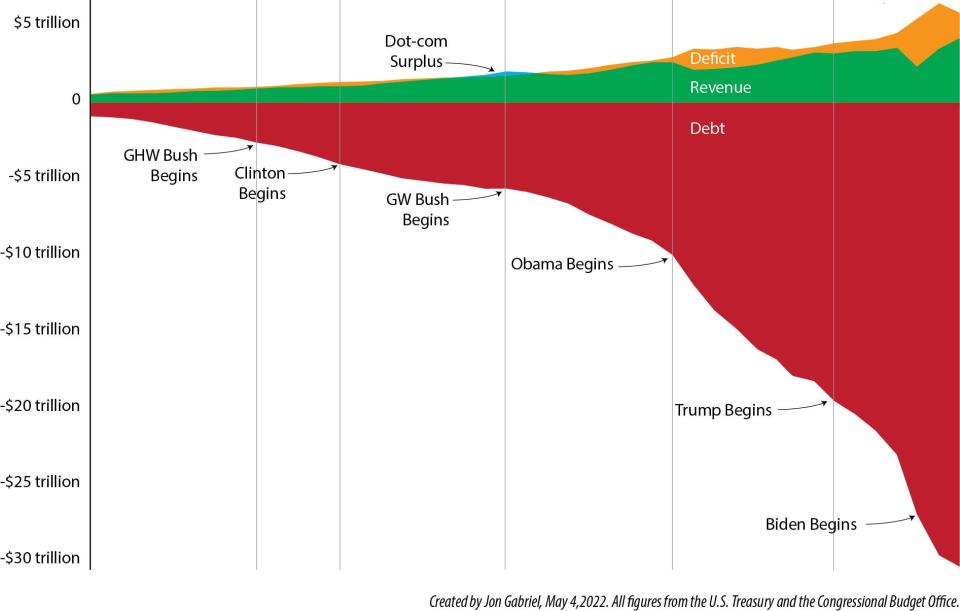Republicans and Democrats spend money we don't have, consequences be damned
What are we talking about these days?
This week, it’s abortion. Before that it was Elon Musk buying Twitter, Russia’s invasion of Ukraine, and COVID-19 restrictions. All are important issues (other than Elon Musk) but our leaders and news media enthusiastically avoid one crisis that has threatened us for decades.
Politicians used to talk about it, as long as they could blame the other party. Today, they’re silent. Yet here I am, like an imperial Japanese soldier on a forgotten Pacific island, fighting a war that ended years ago.
It’s time for my annual op-ed on the national debt.
The chart is bleeding in red national debt
I’ve updated this chart every year since 2012 and it keeps getting worse. After George W. Bush nearly doubled the debt, Barack Obama nearly doubled it again. In his single term, Donald Trump raised it by more than a third. Joe Biden is spending more money we don’t have.
It’s an imperfect analogy, but imagine the green is your salary, the yellow is the amount you’re spending over your salary, and the red is your credit card statement. Then you brag to your spouse, “Don’t worry, dear, I just increased our debt ceiling with a new credit card!”
A simplification to be sure, but that’s what an analogy is. There are few ways humans can wrap their heads around numbers this high.
Most debt graphs look like a toddler threw his spaghetti dinner at the wall, intending to obfuscate rather than educate. That’s why I created a user-friendly debt chart focused on three big numbers: deficit, revenue and debt.
All figures come directly from the U.S. Treasury and the Congressional Budget Office.

Both parties have spent money we don't have
Each update, I see the same complaints. Wonks say the chart should be weighted for this variable or I should add lines showing that trend. Some on the right criticize it as being too harsh on the GOP while most on the left insist that debt doesn’t matter because … well, it just doesn’t, OK?
All are free to create their own charts to better fit their narrative, and I’m sure they will. But the numbers can’t be spun by either side.
An old counterargument claimed the debt was fine because interest rates were at historic lows. Today, those rates are soaring so detractors should retire that canard. I just hope the juvenile idea to mint a few trillion-dollar coins is retired as well.
The chart is brutally bipartisan. Debt increased under Republican presidents and Democratic presidents. It increased under Democratic congresses and Republican congresses. In war and in peace, in boom times and in busts, after tax hikes and tax cuts, the Potomac flowed ever deeper with red ink.
Why aren't we yelling at them to cut more?
Math doesn’t care about fairness or good intentions. Spending vastly more than you have, decade after decade, is foolish when done by a Republican or a Democrat. Two plus two doesn’t equal 33.2317 after you factor in a secret “social justice” multiplier.
If anything, my chart is far too optimistic; I don’t mention future projections due to exploding entitlements. Instead of mocking conservatives for scuttling Build Back Better or attacking Democrats for not funding the military, we should be yelling at all of them to cut more.
Much, much more.
When George W. Bush left office, the federal debt was a staggering $10 trillion. When Obama left, it was $19.5 trillion. As I write this, we are now $30,427,867,588,389 in the red.
Our leaders like to talk about sustainability. Forget sustainable – how is this sane?
Sadly, it seems that no politicians will address the issue. At least until the next massive financial collapse.
Jon Gabriel, a Mesa resident, is editor-in-chief of Ricochet.com and a contributor to The Republic and azcentral.com. Follow him on Twitter at @exjon.
This article originally appeared on Arizona Republic: Debt isn't even a national issue anymore. But it should be

